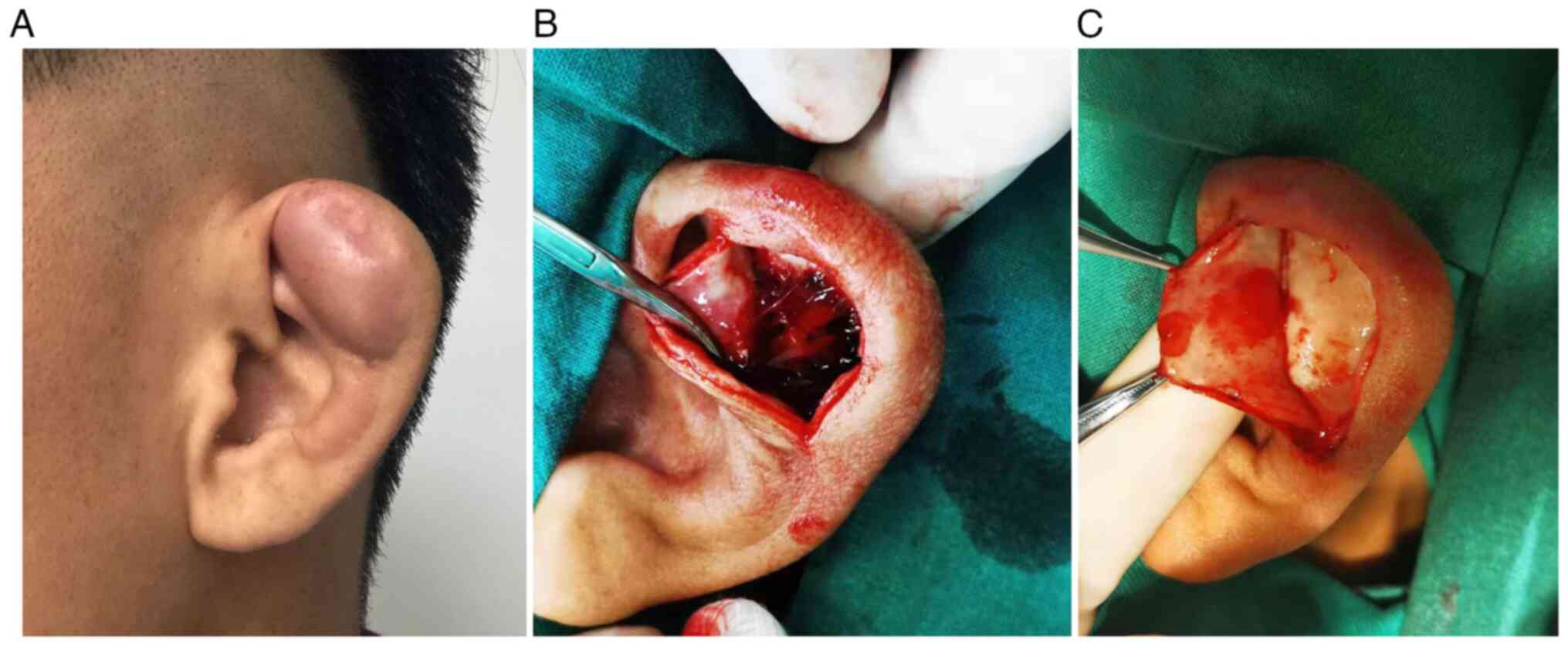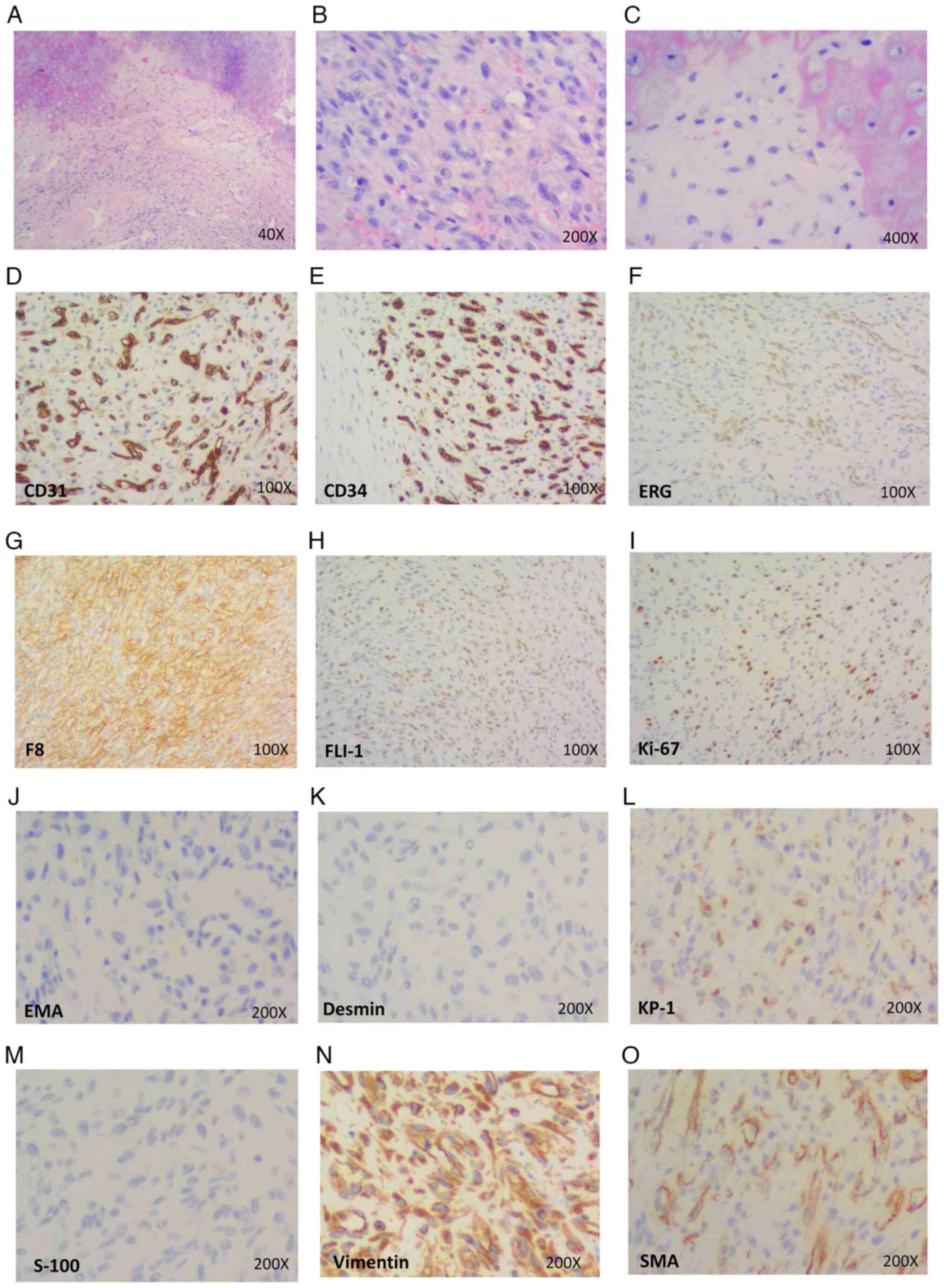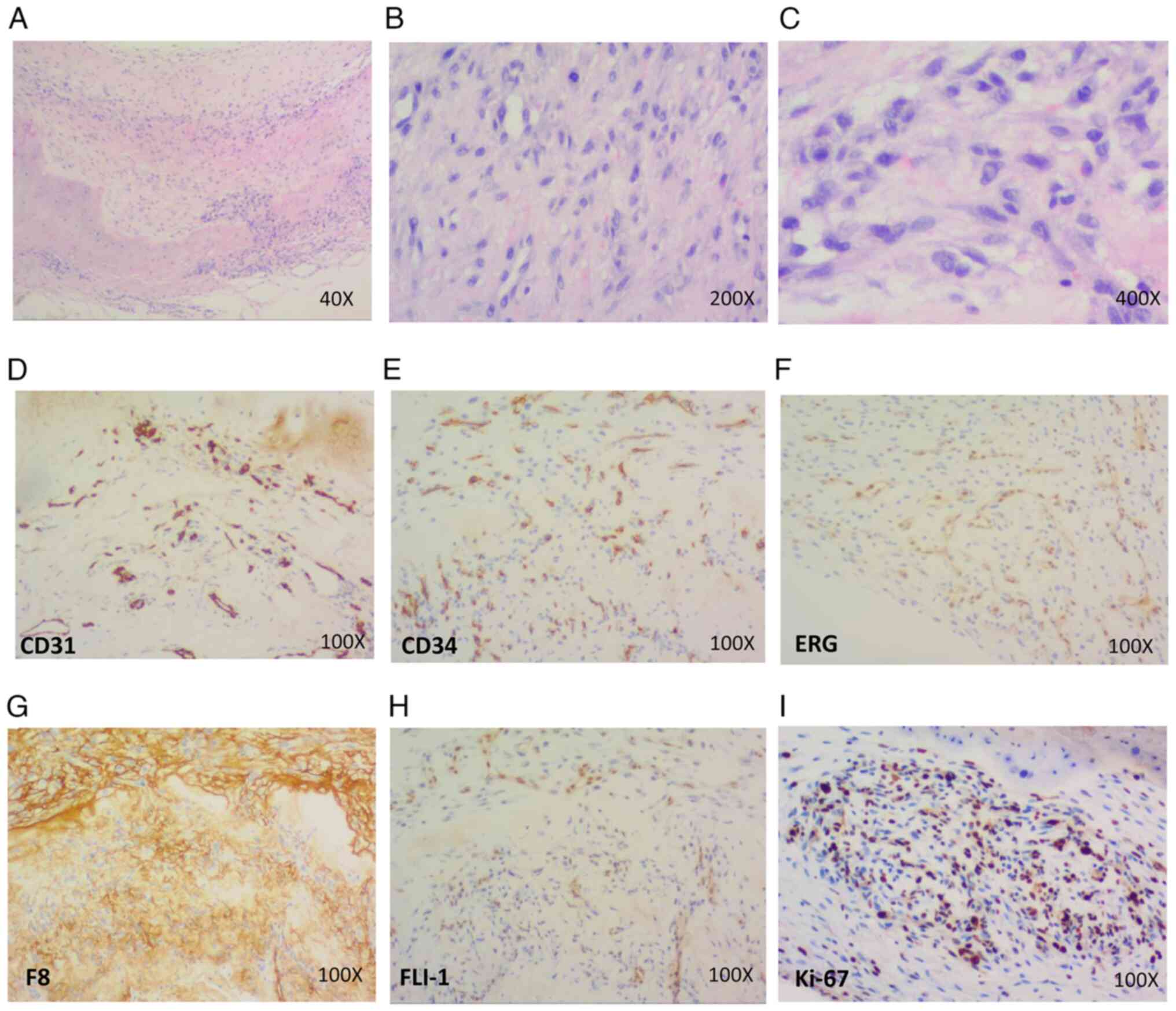Auricular epithelioid hemangioendothelioma: Two cases first diagnosed as auricular pseudocyst
- Authors:
- Published online on: October 21, 2024 https://doi.org/10.3892/ol.2024.14763
- Article Number: 17
-
Copyright: © Wang et al. This is an open access article distributed under the terms of Creative Commons Attribution License.
Abstract
Introduction
Epithelioid hemangioendothelioma (EHE) is a rare soft-tissue vascular neoplasm with a prevalence of one in one million (1). Clinically, EHE can involve the liver alone (21%), liver and lungs (18%), lungs alone (12%) and bones alone (14%), and may occur at various other sites throughout the body (1,2). The clinical manifestations of EHE range from bone pain to neurologic symptoms or swelling at the site of the lesion, and systemic manifestations can include weight loss and anemia (1,3). However, to the best of our knowledge, EHE involving the auricle has not been reported.
It is easy to confuse auricular EHE with auricular pseudocyst in clinical practice since pseudocyst of the auricle presents as an asymptomatic cystoid swelling (4), as does an EHE. EHE can be diagnosed based on morphological characteristics, including intranuclear inclusions, intracytoplasmic vacuoles and stromal changes (5), as well as histological characteristics, including endothelial cells arranged in nests and cords, the presence of spindle-shaped tumor cells and various sized lumens (1). Immunohistochemistry can also be helpful in the diagnosis of EHEs. Positivity for both FLI-1 and CD31 can be considered diagnostic of EHE (6). In the present case report, two patients with clinical symptoms of unilateral soft non inflammatory auricular swelling are described. The initial diagnosis for these two cases was pseudocyst of the auricle. During the surgery, it was found that each cyst had been formed by the accumulation of sterile fluid between two layers of auricular cartilage, which resembled a pseudocyst of the auricle. However, postoperative pathological examination of the cartilage capsule wall suggested a diagnosis of auricular EHE. Immunohistochemical examination showed that the specimens were positive for CD31, CD34, friend leukemia integration 1 (FLI-1), coagulation factor 8 and E26 transformation-specific-related gene (ERG), which was consistent with EHE.
Case reports
Case 1
A 65-year-old man presented with a 5-year history of swelling on the left ear. The swelling initially manifested as a 2×3-mm lesion with pruritus, which gradually increased in size, but did not feel tender. The patient visited the outpatient department of China-Japan Friendship Hospital (Beijing, China). The patient had no history of previous auricular trauma or frostbite. His medical history was unremarkable, except that he had undergone colon cancer surgery in 2009 in a local hospital, 10 years previously. Physical examination detected swelling in the triangular fossa region of the left ear without tenderness (Fig. 1A), and the patient was diagnosed with an auricular pseudocyst. Auricular excision surgery was performed under general anesthesia. During intraoperative examination, it was found that the auricular cartilage was divided into two layers, and the space between these layers was filled with transparent liquid. The effusion was completely aspirated with an aspirator (Fig. 1B), and the swollen upper cartilage and cyst wall were removed (Fig. 1C). A compression bandage was placed on the head of the patient, and broad-spectrum intravenous antibiotics were administered for 2 days.
The removed upper auricular cartilage and the swollen cyst wall were sent for pathological examination (7). Postoperative pathological microscopic examination at low magnification revealed tumor invasion and destruction of cartilage tissue. At medium magnification, the tumor cells were seen to be oval, short spindle-shaped, and scattered or irregularly distributed in sheets. At high magnification, it was observed that the tumor cells had abundant, light-stained eosinophilic cytoplasm, mostly small nuclei, and inconspicuous or small nucleoli. In some areas, vacuoles were visible in the cytoplasm of the tumor cells, and red blood cells were frequently present in the vacuoles. Pathological mitotic figures were rare. Immunohistochemical examination showed that the specimen had a Ki67 index of 20%, as detected using monoclonal antibody Ki67 [MIB-1; Ki67 index] (8). In addition, the specimen was positive for FLI-1, ERG, coagulation factor 8 (F8), CD31, vimentin, the CD68-targeting antibody Ki-61 protein 1 (KP-1; scattered positive) and CD34, and was negative for desmin, S100, α smooth muscle actin (α-SMA) and epithelial membrane antigen (EMA) (Fig. 2).
These examination results led to a pathological diagnosis of low-grade malignant angiogenic tumor, consistent with EHE. The 2-year follow-up after surgery showed that no tumor was present in the auricle. The last follow-up was conducted and the patient did not revisit in the later stage.
Case 2
A 48-year-old man presented with a 1-month history of pruritic swelling of his right ear on October 30, 2019. The swelling increased gradually without redness, purulence or tenderness. No history of previous trauma or frostbite was reported. The patient had been repeatedly treated with cyst puncture and compression in other hospitals, but the swelling was not relieved after treatment, and gradually became aggravated and tender. The patient presented at China-Japan Friendship Hospital (Beijing, China) for further treatment. During physical examination, swelling in the triangular fossa region of the right ear was observed, with tenderness on palpation. Based on these findings, the patient was diagnosed with an auricular pseudocyst. The auricular lesion was excised under general anesthesia, with intraoperative examination revealing an accumulation of sterile fluid between the layers of the auricular cartilage. Following complete aspiration of the effusion using an aspirator, the swollen upper cartilage and cyst wall were removed and sent for pathological examination (8). Intraoperative frozen pathology revealed that the resection margin was free of tumor cells. However, no clinical or surgical images of case 2 were captured at the time of treatment. A compression bandage was applied to the head of the patient, and broad-spectrum intravenous antibiotics were administered for 2 days.
The postoperative pathological features of case 2 were consistent with those of case 1. Specifically, immunohistochemical examination showed that the lesion had a Ki67 (MIB-1) index of 20% and was positive for CD31, F8, CD34, FLI-1 and ERG (Fig. 3). The pathology report also disclosed that the lesion was scattered positive for KP-1, and negative for desmin, α-SMA, S-100 and EMA (data not shown) (8).
Pathologic examination of the specimens isolated from the patient led to the diagnosis of an angiogenic tumor. The morphology and immunohistochemistry of the lesion were consistent with those of EHE. A follow-up performed 6 months after surgery revealed that no new tumor was present in the auricle. The last follow-up was conducted and the patient did not revisit in the later stage.
Discussion
EHE is an extremely rare tumor that develops from vascular endothelial or pre-endothelial cells (1). EHE was initially described in 1975 and named epithelioid hemangioendothelioma in 1982 (1,9). EHE tends to present during middle age, with a median age of 36 years, and is 4-fold more common in women than men (1). Approximately 30% of these tumors present as pulmonary EHEs, which are typically first diagnosed incidentally from abnormal chest imaging results (10). Other primary sites of EHE include subcutaneous fat, bone, retroperitoneum, lymph nodes, ovaries, prostate glands, eyelids and pleura (1,2). The clinical manifestations of EHE range from bone pain to neurologic symptoms or swelling at the site of the lesion, and systemic manifestations can include weight loss and anemia (1,3). To the best of our knowledge, only three cases of pseudocysts associated with malignant tumors have been reported, where the malignant tumors include lymphoma and hepatocellular carcinoma (11–13), and EHE has not been previously reported in the auricles.
EHE in the auricle is easily misdiagnosed as auricular pseudocyst due to these two conditions having similar clinical symptoms. Pseudocysts, first described in 1966 (14), manifest as rare benign swellings; when they affect the auricles, they are characterized by degeneration and separation of the cartilage, and subsequent cyst formation (11). Most pseudocysts of the auricles present as asymptomatic, unilateral soft skin-colored noninflammatory swellings (11). The two patients described in the present case report presented with noninflammatory swelling of the auricle, with intraoperative examinations showing that these cysts comprised an accumulation of sterile fluid between layers of auricular cartilage. These clinical manifestations and intraoperative findings are not able to distinguish auricular pseudocyst from auricular EHE. The final diagnosis requires postoperative pathological examination. Auricular pseudocysts are characterized by the infiltration of chronic inflammatory cells without the destruction of auricular cartilage (4,11). However, the postoperative pathology of the two patients in the present study showed the presence of scattered or irregularly distributed tumor cells that were oval or short fusiform in morphology. In some of the tumor cells, vacuoles were present in the cytoplasm, and numerous red blood cells were visible in the vacuoles. Pathological mitoses were rare. Also, the cartilage was invaded by low-grade malignant tumor cells, and immunohistochemical analyses showed that the tumor cells were positive for the vascular markers F8, ERG, CD34, CD31 and FLI-1. These pathological characteristics indicate that these lesions were hemangioendotheliomas.
EHE can be diagnosed based on morphological characteristics, including intranuclear inclusions, intracytoplasmic vacuoles and stromal changes (5), as well as histological characteristics, including endothelial cells arranged in nests and cords, the presence of spindle-shaped tumor cells and various sized lumens (1). Some cells contain intracytoplasmic inclusions, resulting in a signet-ring appearance (15). Immunohistochemistry can also be helpful in the diagnosis of EHEs. CD34 is a vascular tumor marker expressed in 90% of vascular tumors and is not specific for EHE (1). By contrast, CD31 is more specific, and FLI-1, a transcription factor expressed in endothelial cells, is important for revealing the vascular nature of EHE (1). Therefore, positivity for both FLI-1 and CD31 can be considered diagnostic of EHE (6).
Due to the low incidence of EHE, no optimal treatment strategy has yet been designed. Localized lesions can be surgically resected, whereas watchful waiting may be considered as a reasonable strategy for patients with asymptomatic diffuse lesions (10). The treatment options for patients with metastatic EHE include cytotoxic chemotherapy, immunotherapy and targeted therapy (2). A recently reported case (16) diagnosed with pulmonary endovascular EHE was treated with tri-weekly paclitaxel (175 mg/m2) and carboplatin (area under the curve 5) chemotherapy regimen. A clear response was observed after 5 cycles (21 days per cycle) and pembrolizumab (200 mg once monthly) as maintenance treatment. Similarly, Ye et al (17) reported that three patients with pulmonary EHE who received combination chemotherapy with carboplatin, paclitaxel and bevacizumab all achieved partial responses. They survived after follow-up for 6–25 months. However, the efficacy of chemotherapy is still uncertain. Bansal et al (18) reported a patient with pleural EHE who died due to disease progression after 4 months, even after the use of chemotherapy. In addition to surgery, the efficacy of postoperative external beam irradiation has also been studied. A previous study of 5 patients with spinal EHE found that 4 of the patients received surgery and postoperative external beam irradiation. One of these patients died 34 months after surgery, and the others survived for 25–72 months of follow-up (19). Some researchers have shifted their focus toward targeted molecular therapy. For instance, apatinib provided some symptomatic improvements and positive imaging changes in a case of pulmonary EHE (20). In addition, sorafenib achieved a partial response in a case of liver EHE (21), and the treatment of multi-metastatic pulmonary EHE with pazopanib for >2 years resulted in a stable disease (22). The two patients in the present study had Ki67 (MIB-1) indices of 20%, suggesting that their tumors were of low malignancy. Both patients recovered after surgical resection, and showed no evidence of tumor recurrence on follow-up.
In summary, auricular EHE is rare and lacks typical clinical features, with clinical manifestations similar to those of auricular pseudocysts. Comprehensive analysis of clinical, imaging and pathomorphological results is important, but the final diagnosis mainly depends on histopathology and immunohistochemistry. In cases when the course of disease is prolonged and symptomatic treatment has been ineffective, the possibility of a tumor should be considered. If the tumor is highly malignant, radiotherapy and chemotherapy can be administered. However, the effectiveness of radiotherapy and chemotherapy for the treatment EHE is poor, and there is no ideal targeted drug therapy at present. Postoperative follow-up is necessary to prevent recurrence. Therefore, it is necessary to conduct a thorough analysis, carefully observe, and accumulate experience by integrating relevant clinical cases.
Acknowledgements
Not applicable.
Funding
The present study was supported by National High Level Hospital Clinical Research Funding, Elite Medical Professionals project of China-Japan Friendship Hospital (grant no. ZRJY2021-QM03) and the National Natural Science Foundation of China (grant no. 82101235).
Availability of data and materials
The data generated in the present study may be requested from the corresponding author.
Authors' contributions
JL and YW were responsible for conceptualization. YN and ZM analyzed the pathological sections. JZ and RZ performed the case review and collected the medical records. YW prepared the original draft of the manuscript. JZ, YN and JL reviewed and edited the manuscript. JW and JL checked and confirmed the authenticity of the raw data. All authors read and approved the final version of the manuscript.
Ethics approval and consent to participate
Not applicable.
Patient consent for publication
The patients provided written informed consent for the publication of their case reports, including case data and images.
Competing interests
The authors declare that they have no competing interests.
References
|
Sardaro A, Bardoscia L, Petruzzelli MF and Portaluri M: Epithelioid hemangioendothelioma: An overview and update on a rare vascular tumor. Oncol Rev. 8:2592014. | |
|
Rosenberg A and Agulnik M: Epithelioid Hemangioendothelioma: Update on diagnosis and treatment. Curr Treat Options Oncol. 19:192018. View Article : Google Scholar | |
|
Bagan P, Hassan M, Barthes FL, Peyrard S, Souilamas R, Danel C and Riquet M: Prognostic factors and surgical indications of pulmonary epithelioid hemangioendothelioma: A review of the literature. Ann Thorac Surg. 82:2010–2013. 2006. View Article : Google Scholar | |
|
Cohen V, Fortier-Riberdy G, Saliba I and Davar S: A case of auricular pseudocyst. J Cutan Med Surg. 20:573–574. 2016. View Article : Google Scholar | |
|
Anderson T, Zhang L, Hameed M, Rusch V, Travis WD and Antonescu CR: Thoracic epithelioid malignant vascular tumors: A clinicopathologic study of 52 cases with emphasis on pathologic grading and molecular studies of WWTR1-CAMTA1 fusions. Am J Surg Pathol. 39:132–139. 2015. View Article : Google Scholar | |
|
Gill R, O'Donnell RJ and Horvai A: Utility of immunohistochemistry for endothelial markers in distinguishing epithelioid hemangioendothelioma from carcinoma metastatic to bone. Arch Pathol Lab Med. 133:967–972. 2009. View Article : Google Scholar | |
|
Tosta TA, de Faria PR, Neves LA and do Nascimento MZ: Computational normalization of H&E-stained histological images: Progress, challenges and future potential. Artif Intell Med. 95:118–132. 2019. View Article : Google Scholar | |
|
Ribeiro MB and Ibiapina JO: Immunohistochemical analysis by KI67 and IDH1 in patients with chondrosarcoma. Acta Ortop Bras. 31:e2672122023. View Article : Google Scholar | |
|
Weiss SW and Enzinger FM: Epithelioid hemangioendothelioma: A vascular tumor often mistaken for a carcinoma. Cancer. 50:970–981. 1982. View Article : Google Scholar | |
|
Kitaichi M, Nagai S, Nishimura K, Itoh H, Asamoto H, Izumi T and Dail DH: Pulmonary epithelioid haemangioendothelioma in 21 patients, including three with partial spontaneous regression. Eur Resp J. 12:89–96. 1998. View Article : Google Scholar | |
|
Abbas O, Chedraoui A, Baki JA, Kibbi AG and Ghosn S: Bilateral auricular pseudocysts as the presenting sign of hepatocellular carcinoma. Clin Exp Dermatol. 35:e34–e36. 2010. View Article : Google Scholar | |
|
Pereira FC, Chinelli PA, Takahashi MD and Nico MM: Bilateral pseudocyst of the auricle in a man with pruritus secondary to lymphoma. Int J Dermatol. 42:818–821. 2003. View Article : Google Scholar | |
|
Hoffmann TJ, Richardson TF, Jacobs RJ and Torres A: Pseudocyst of the auricle. J Dermatol Surg Oncol. 19:259–262. 1993. View Article : Google Scholar | |
|
Engel D: Pseudocysts of the auricle in Chinese. Arch Otolaryngol. 83:197–202. 1966. View Article : Google Scholar | |
|
Flucke U, Vogels RJ, de Saint Aubain Somerhausen N, Creytens DH, Riedl RG, van Gorp JM, Milne AN, Huysentruyt CJ, Verdijk MA, van Asseldonk MM, et al: Epithelioid hemangioendothelioma: Clinicopathologic, immunhistochemical, and molecular genetic analysis of 39 cases. Diagn Pathol. 9:1312014. View Article : Google Scholar | |
|
Guo W, Zhou D, Huang H, Chen H, Wu X, Yang X, Ye H and Hong C: Successful chemotherapy with continuous immunotherapy for primary pulmonary endovascular epithelioid hemangioendothelioma: A case report. Medicine (Baltimore). 102:e329142023. View Article : Google Scholar | |
|
Ye B, Li W, Feng J, Shi JX, Chen Y and Han BH: Treatment of pulmonary epithelioid hemangioendothelioma with combination chemotherapy: Report of three cases and review of the literature. Oncol Lett. 5:1491–1496. 2013. View Article : Google Scholar | |
|
Bansal A, Chawla M, Cohen PJ and Kwon JS: Pleural epithelioid hemangioendothelioma. Lung. 190:469–470. 2012. View Article : Google Scholar | |
|
Ma J, Wang L, Mo W, Yang X and Xiao J: Epithelioid hemangioendotheliomas of the spine: Clinical characters with middle and long-term follow-up under surgical treatments. Eur Spine J. 20:1371–1376. 2011. View Article : Google Scholar | |
|
Zheng Z, Wang H, Jiang H, Chen E, Zhang J and Xie X: Apatinib for the treatment of pulmonary epithelioid hemangioendothelioma: A case report and literature review. Medicine (Baltimore). 96:e85072017. View Article : Google Scholar | |
|
Kobayashi N, Shimamura T, Tokuhisa M, Goto A and Ichikawa Y: Sorafenib Monotherapy in a patient with unresectable hepatic epithelioid hemangioendothelioma. Case Rep Oncol. 9:134–137. 2016. View Article : Google Scholar | |
|
Semenisty V, Naroditsky I, Keidar Z and Bar-Sela G: Pazopanib for metastatic pulmonary epithelioid hemangioendothelioma-a suitable treatment option: Case report and review of anti-angiogenic treatment options. BMC Cancer. 15:4022015. View Article : Google Scholar |













